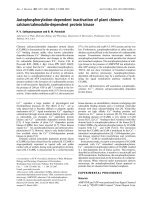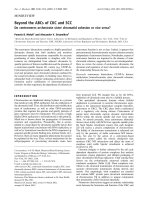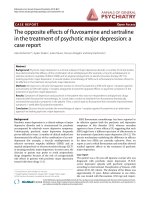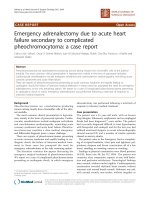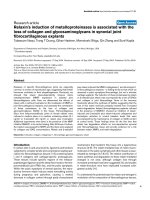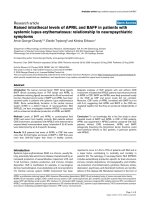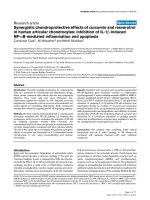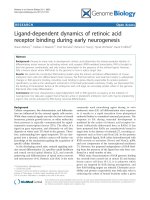Báo cáo y học: "Stimulation dependent induction of fear and depression in deep brain stimulation: a case report" docx
Bạn đang xem bản rút gọn của tài liệu. Xem và tải ngay bản đầy đủ của tài liệu tại đây (188.79 KB, 4 trang )
Case report
Open Access
Stimulation dependent induction of fear and depression in deep
brain stimulation: a case report
Michael Sabolek
1,2
*, Ingo Uttner
2
, Klaus Seitz
3
, Eduard Kraft
4
and
Alexander Storch
5
Addresses:
1
Department of Neurology, EMA-University of Greifswald, Greifswald, Germany
2
Department of Neurology, University of Ulm, Ulm, Germany
3
Department of Neurosurgery, University of Ulm, Günzburg, Germany
4
Department of Physical Medicine and Rehabilitation, Clinic Großhadern, University of Munich, Munich, Germany
5
Department of Neurology, Dresden University of Technology, Dresden, Germany
Email: MS* -
* Corresponding author
Received: 16 June 2008 Accepted: 30 April 2009 Published: 11 September 2009
Journal of Medical Case Reports 2009, 3:9136 doi: 10.4076/1752-1947-3-9136
This article is available from: />© 2009 Sabolek et al.; licensee Cases Network Ltd.
This is an Open Access article distributed under the terms of the Creative Commons Attribution License (
/>which permits unrestricted use, distribution, and reproduction in any medium, provided the original work is properly cited.
Abstract
Introduction: Psychiatric side effects of deep brain stimulation are not uncommon. It is often
limited to transient mood alterations. We report for the first time a case of acute stimulation-
dependent fear during intraoperative test stimulation.
Case presentation: During test stimulation for electrode placement to the left subthalamic
nucleus, a 58-year-old caucasian man with Parkinson’s disease developed a severe reproducible
feeling of fear together with elevated heart rate and sweating. Postoperatively, the patient developed
a therapy refractory major depression in spite of excellent motor-control. Reprogramming the
stimulator using a more rostral contact resulted in an abrupt and complete disappearance of the
depressive syndrome.
Conclusion: Postoperative re-evaluation of the stimulation site of the patient inducing acute fear by
analyzing his intraoperative microrecordings and Talairach coordinates revealed stimulation within
his right substantia nigra. The contrast analysis of the postoperative stimulation site suggests induction
of depression in the patient by stimulation of the caudal part of his subthalamic nucleus. Acute
psychiatric side effects of deep brain stimulation are relatively rare but must not be overlooked while
concentrating on the improvement of motor deficit.
Introduction
Bilateral deep brain stimulation (DBS) in the subthalamic
nucleus (STN) is an accepted and standardized therapy in
patients of advanced Parkinson’s disease (PD) [1].
Permanent STN-DBS leads to an average of 50% improve-
ment of motor function [2] and allows for the reduction of
antiparkinsonian medication to approximately 50-65%
of the pre-operative dosage [3]. It is well accepted that
Page 1 of 4
(page number not for citation purposes)
chronic STN-DBS not only affects motor function of
patients, but also t heir psychic beha viour, including
impairment of their executive functions and cognition as
well as mood changes like mania and depression [4-9].
There are, however, very few reports of acute, stimulation
dependent mood changes among patients [9-11]. Here we
report the first case of acute severe stimulation-dependent
fear.
Case presentation
A 58-year-old Caucasian man with a 13-year disease
history of Parkinson’s disease was experiencing severe
motor fluctuations. His preoperative medication included
high doses of pergolide (24 mg/d) and levodopa
(1400 mg/d) plus entacapone. The decision was made to
implant bilateral DBS electrodes into the STN of the
patient. Preoperatively, there were no signs of anxiety or
depression (Beck-Depression-Inventory: 3). Implantation
trajectories and target points were planned using stereo-
tactic CCT (cerebral computed tomography) technology
and FrameLink™ stereotactic planning software. The
calculated STN positions (Table 1) were in the normal
range of STN positions reported in the medical literature
[12-14]. Intraoper atively the electr ode positions were
adjusted using a Leksell® stereotactic arc. Intraoperative
neurophysiological recordings were performed using a five
microelectrode recording system (LeadPoint®, Medtronic
Inc.). During test macro-stimulation (right hemisphere),
3 mm below the calculated target point (Table 1), the
patient exper ienced sudden severe fear together with
sudden elevation of blood pressure [> 210 mm Hg
systolic], tachycardia [> 150/min.], tachypnoea and severe
sweating, which was already at a current of 1.5 mA. After
terminating the stimulation, the fear completely vanished
in a few seconds. The phenomenon was reproducible in a
second unannounced test-stimulation. Another test sti-
mulation, 2 mm more rostral, provided excellent motor
symptom control with no apparent side effects, so the DBS
electrodes were implanted in this position. Postoperative
physical recovery was promising (Table 1). However, the
patient constantly complained of feelings of sadness,
depression, diffuse anxiety, reduced drive and loss of
interest. The clinical picture met the criteria for a major
depression according to DSM IV and ICD-10. Ratings of
Hamilton Depression Scale (HAMDS) and Beck Depression
Inventory (BDI) were also compatible with the clinical
diagnosis of major depression (Table 1). Standard treat-
ment with selective serotonin reuptake inhibitors (SSRI)
had no effect. Extensive neuropsychological examination
(memory [block and word span, Munich Verbal Memory
Test, Continuous Visual Memory Test, Boston Naming],
attention [Trail Making Test, Stroop Test], frontal executive
functions [Controlled Oral Word Association Test, Seman-
tic Fluency, Colored Progressive Matrices] and intelligence
[Vocabulary Test]) revealed no substantial cognitive
imp airm ent. Since persistent treatment-res istant post-
operative depression is unusual [5,6] after 3 months we
decided to try to change the stimulation parameters
despite excellent motor control. After terminating the
stimulation, severe bradykinesia and tremor reappeared
within seconds. Nevertheless, the patient reported a fast
and pronounced improvement of mood which correlated
with HMDS and BDI scoring (Table 1). With the patient’s
consent, we tested the reproducibility of the induction of
depression and found acute onset of depression and
diffuse anxiety after restarting the stimulation. Afterwards,
we altered the stimulation parameters using a more rostral
contact on both sides (Table 1). These parameters
provided good motor control with no side effects on
mood. BDI and HAMDS remained normal (Table 1). At all
Table 1. Electrode positions and clinical stimulation effects
Position in relation to
mid-commissural point
Left Right UPDRS III BDI HAMDS
x (medial-
lateral)
y (ventral-
dorsal)
z (rostral-
caudal)
x (medial-
lateral)
y (ventral-
dorsal)
z (rostral-
caudal)
Calculated STN
position
−12 −2 −412−2 −4
Intraoperative
macrostimulation
−9 −2 −8 11 −2 −7
Postoperative
stimulation
Stimulator off
45 4 5
Contact position:
depression
−9 −2 −4.5 to −3.0 11 −3 −3.5 to −2.0 12 14 14
Contact position:
no depression
−9 −2 −2.5 to −1.0 11 −3 −1.5 to 0.0 14 3 5
STN: Subthalamic nucleus.
BDI: Beck depression inventory.
HAMDS: Hamilton Depression scale.
UPDRS III: Unified Parkinson’s disease rating scale, motorscale.
Bold Boxes: Fear induction at this electrode position.
Page 2 of 4
(page number not for citation purposes)
Journal of Medical Case Reports 2009, 3:9136 />points, standard stimulation parameters (130 Hz, 60 µs,
up to 3.5 V) were used.
Conclusion
While STN-DBS in advanced PD patients leads to
impressive improvement in motor disability, several
reports mention possible psychiatric side effects [6-9].
Whereas depressive episodes are reported in a subgroup of
patients [11], most patients experience a long-term
improvement in depression scores in comparison with
preoperative state. Long lasting depressive state is an
uncommon side effect of STN stimulation [5,11]. Other
symptoms such as lack of initiation, apathy, social
withdrawal, lability, moodiness, insensitivity and mania
were also reported [5,9,11,15]. In a recent article, apathy,
defined as “lack of motivation, interest or emotions,” was
attributed to a direct stimulation of the STN [15]. These
symptoms seemed apparent in our patient. Therefore, this
known side effect may have contributed to the clinical
picture interpreted as depressive mood. In contrast to these
chronic side effects, there are few reports about an acute
influence of DBS on mood [9-11]. This is the first report of
acute stimulation-dependent induction of fear. Here the
electrode position was 3 mm caudal of the calculated
target point for the STN and, according to Talairach
coordinates, within the substantia nigra pars reticulate
(SNR) (Table 1). Re-evaluation of the intraoperative
micro-recordings confirmed that the stimulation position
was 0.5 mm caudal of the beginning of SNR typical
signals. The electrode position inducting the postoperative
depressive state, re-evaluated using postoperative stereo-
tactic CCT technique, was 3.5 mm rostral of this position
and clearly away from the SNR. On both sides it was very
close to the calculated STN position (Table 1) and at the
lower end of STN typical signals during intraoperative
micro-recording. In a prospective study of 17 patients,
intraoperative stimulation-dependent autonomic side
effects were reported in 19.6% of the test stimulations
at a mean voltage of 3.1 V. The nature of these autonomic
side effects was heterogeneous (confusion, malaise, chest
congestion, abdominal discomfort, feeling of anguish,
anxiety or stress, feeling of warmth or cold that was either
diffused or restricted to the face, unilateral or bilateral
mydriasis, diffused or local excessive sweating, diffused or
hemifacial flushing, mild tachycardia and mild hyperten-
sion) [16]. These s ide effects were observed during
stimulation in an area of 3.2 × 4.6 × 2.4 mm and the
calculated mean point was within the STN according to
Talairach coordinates [16]. Given the mean diameter of
the STN of 2.5-2.5 mm and the variety of side effects, a
direct attri bution of all of these side effects to one
particular spot is difficult. Also the authors of this article
expressed concern that the stimulation volume during a
stimulation of 3.1 V may be sufficient to involve
autonomic structures neighbouring the STN [16]. In our
case, the direct induction of fear was observed at very low
currents of 1.5 mA. Therefore, unintentional stimulation
of neighbouring structures due to a large electrical field is
unlikely. This strongly suggests that the observed induc-
tion of fear was due to direct stimulation of the SNR.
Furthermore, this side effect appeared at the position,
where SNR typical signals were recorded prior to test-
stimulation. Our findings may contribute to intraoperative
electrode localisation particularly in cases where intra-
operative micro-recording shows no clear SNR signals. It
means that the appearance of acute fear during test
stimulation might indicate an electrode position within
the SNR.
Consent
Written informed consent was obtained from the patient’s
children for publication of this case report and accom-
panying images. This was necessary as the patient himself
subsequently died. A copy of the written consent is
available for review by the Editor-in-Chief of this journal.
Competing interests
The authors declare that they have no competing interests.
Authors’ contributions
MS and AS performed intraoperative micro-recording,
macro-stimulation and functional testing. KS performed
the surgical procedure and the trajectory planning. EK and
KS performed the postoperative interpretation of the
different stimulation sites concerning Talairach coordi-
nates. MS and AS performed the postoperative interpreta-
tion of the micro-recording results. MS and IU performed
postoperative video documentation during reprogram-
ming. IU performed all pre- and postoperative neuropsy-
chological examinations and tests and interpreted these.
MS and AS finalized the manuscript.
References
1. Benabid AL, Chabardes S, Seigneuret E: Deep-brain stimulation in
Parkinson’s disease: long-term efficacy and safety - What
happened this year? Curr Opin Neurol 2005, 18:623-630.
2. Rodriguez-Oroz MC, Obeso JA, Lang AE, Houeto JL, Pollak P,
Rehncrona S, Kulisevsky J, Albanese A, Volkmann J, Hariz MI et al.:
Bilateral deep brain stimulation in Parkinson’s disease:
a multicentre study with 4 years follow-up. Brain 2005,
128:2240-2249.
3. Volkmann J, Allert N, Voges J, Weiss PH, Freund HJ, Sturm V: Safety
and efficacy of pallidal or subthalamic nucleus stimulation in
advanced PD. Neurology 2001, 56:548-551.
4. Ardouin C, Pillon B, Peiffer E, Bejjani P, Limousin P, Damier P, Arnulf I,
Benabid AL, Agid Y, Pollak P: Bilateral subthalamic or pallidal
stimulation for Parkinson’s disease affects neither memory
nor executive functions: a consecutive series of 62 patients.
Ann Neurol 1999, 46:217-223.
5. Funkiewiez A, Ardouin C, Caputo E, Krack P, Fraix V, Klinger H,
Chabardes S, Foote K, Benabid AL, Pollak P: Long term effects of
bilateral subthalamic nucleus stimulation on cognitive func-
tion, mood, and behaviour in Parkinson’s disease. J Neurol
Neurosurg Psychiatry 2004, 75:834-839.
6. Schneider F, Habel U, Volkmann J, Regel S, Kornischka J, Sturm V,
Freund HJ: Deep brain stimulation of the subthalamic nucleus
Page 3 of 4
(page number not for citation purposes)
Journal of Medical Case Reports 2009, 3:9136 />enhances emotional processing in Parkinson disease. Arch Gen
Psychiatry 2003, 60:296-302.
7. Jahanshahi M, Ardouin CM, Brown RG, Rothwell JC, Obeso J,
Albanese A, Rodriguez-Oroz MC, Moro E, Benabid AL, Pollak P et al.:
The impact of deep brain stimulation on executive function
in Parkinson’s disease. Brain 2000, 12361142-1154.
8. Saint-Cyr JA, Trepanier LL, Kumar R, Lozano AM, Lang AE:
Neuropsychological consequences of chronic bilateral stimu-
lation of the subthalamic nucleus in Parkinson’s disease. Brain
2000, 123:2091-2108.
9. Funkiewiez A, Ardouin C, Krack P, Fraix V, Van Blercom N, Xie J,
Moro E, Benabid AL, Pollak P: Acute psychotropic effects of
bilateral subthalamic nucleus stimulation and levodopa in
Parkinson’s disease. Mov Disord 2003, 18:524-530.
10. Bejjani BP, Damier P, Arnulf I, Thivard L, Bonnet AM, Dormont D,
Cornu P, Pidoux B, Samson Y, Agid Y: Transient acute depression
induced by high-frequency deep-brain stimulation. N Engl J
Med 1999, 340:1476-1480.
11. Takeshita S, Kurisu K, Trop L, Arita K, Akimitsu T, Verhoeff NP:
Effect of subthalamic stimulation on mood state in Parkin-
son’s disease: evaluation of previous facts and problems.
Neurosurg Rev 2005, 28:179-186; discussion 187.
12. Guridi J, Rodriguez-Oroz MC, Lozano AM, Moro E, Albanese A,
Nuttin B, Gybels J, Ramos E, Obeso JA: Targeting the basal
ganglia for deep brain stimulation in Parkinson’s disease.
Neurology 2000, 55:S21-S28.
13. Richter EO, Hoque T, Halliday W, Lozano AM, Saint-Cyr JA:
Determining the position and size of the subthalamic nucleus
based on magnetic resonance imaging results in patients with
advanced Parkinson disease. J Neurosurg 2004, 100:541-546.
14. Hamel W, Fietzek U, Morsnowski A, Schrader B, Herzog J,
Weinert D, Pfister G, Muller D, Volkmann J, Deuschl G et al.:
Deep brain s timulation of the subthalamic nucleus in
Parkinson’s disease: evaluation of active electrode contacts.
J Neurol Neurosurg Psychiatry 2003, 74:1036-1046.
15. Drapier D, Peron J, Leray E, Sauleau P, Biseul I, Drapier S, Le Jeune F,
Travers D, Bourguignon A, Haegelen C et al.: Emotion recognition
impairment and apathy after subthalamic nucleus stimula-
tion in Parkinson’s disease have separate neural substrates.
Neuropsychologia 2008, 46:2796-2801.
16. Sauleau P, Raoul S, Lallement F, Rivier I, Drapier S, Lajat Y, Verin M:
Motor and non motor effects during intraoperative subtha-
lamic stimulation for Parkinson’s disease. Journal of neurology
2005, 252:457-464.
Do you have a case to share?
Submit your case report today
• Rapid peer review
• Fast publication
• PubMed indexing
• Inclusion in Cases Database
Any patient, any case, can teach us
something
www.casesnetwork.com
Page 4 of 4
(page number not for citation purposes)
Journal of Medical Case Reports 2009, 3:9136 />

